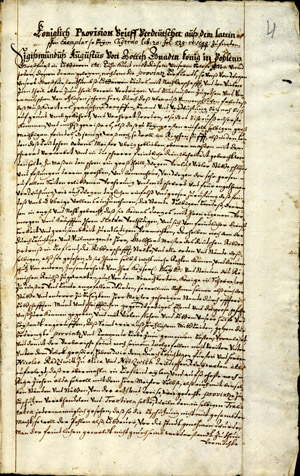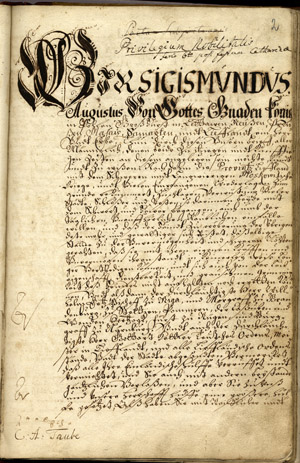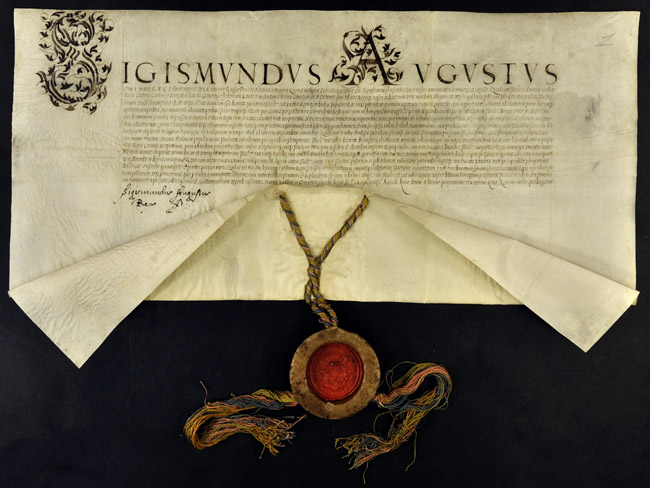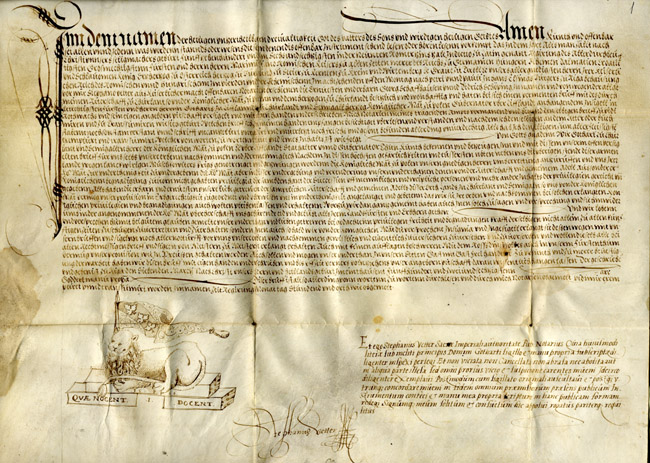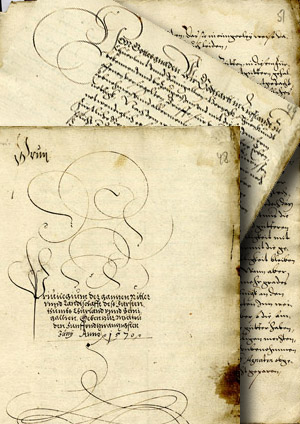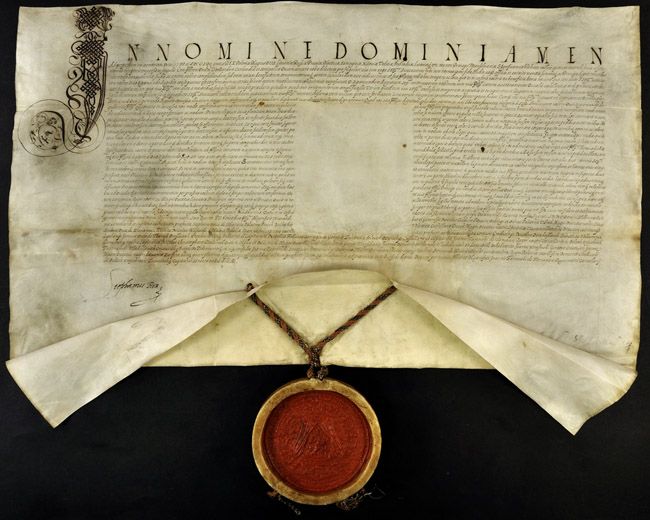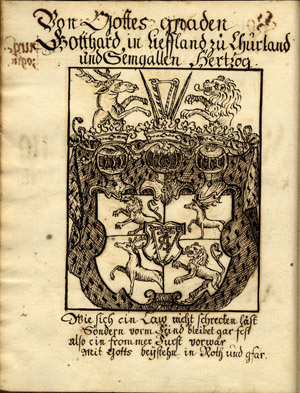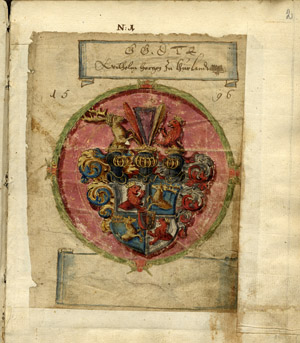Establishment of the Duchy
The abolition of the Livonian Confederation was one of the events marking the transition from the Middle Ages to the Early Modern Era in the Baltic. Unable to stand up to the military might of Muscovy during the Livonian War (15581582), the rulers of Livonia were forced to seek the help of neighbouring states as allies. As a result, North Estonia surrendered to the King of Sweden, while the rest of Livonia submitted to Sigismund II Augustus, the King of Poland and Grand Duke of Lithuania. The legal submission to Sigismund II Augustus took place in Vilnius on 28 November 1561 with the conclusion of the agreement known as the Pacta Subiectionis. Under the terms of the pact, Gotthard Kettler, the last Master of the Livonian Order, obtained the order's former properties in Courland and Semigallia as a heritable duchy held as a fief, while the rest of the country, north of the River Daugava, came under the direct control of Sigismund II Augustus. 28 November 1561 can be regarded as the de jure date of founding of the Duchy of Courland and Semigallia (Ducatus Curlandiae et Semigalliae). Simultaneously with the agreement, a second basic document of the duchy came into being, known as the Privilege of Sigismund Augustus. In neighbouring Livland its legality was disputed, but this was never the case in Courland.
The act of submission was implemented in Riga Castle on 5 March 1562. The master and other leaders of the order solemnly gave up their posts and the order itself was secularised. After this, Gotthard Kettler, now a secular duke, gave an oath of fidelity to Sigismund II Augustus as ruler of Lithuania, becoming a vassal of the King of Poland-Lithuania, and the former brothers of the order swore allegiance to the new duke as his subjects. Thus, the Duchy of Courland was founded de facto on 5 March 1562.
1. Excerpt from the German translation of the Pacta Subiectionis concluded in Vilnius on 28 November 1561. LVVA, Collection 640, Inventory 4, File 239.
The Pacta Subiectionis was more commonly referred to in the Duchy of Courland as Provisio Ducalis (literally “The Duke’s Subsistence”). It established the basic principles of the new state. The King of Poland guaranteed the Courlanders: 1) freedom of religion in accordance with the Augsburg Confession, 2) continuation of the rights and privileges enjoyed hitherto and the right of family members of both sexes to inherit landed estates, 3) the right of the native Germans to hold official posts. Gotthard Kettler was granted a title, regalia and honours equal to those of the Duke of Prussia. The original document is in Latin. Soon after it was concluded, a large number of copies and German translations appeared. The original is nowadays held at the Herder Institute, Marburg (Germany).
2. First page of the Privilege of Sigismund Augustus of 28 November 1561. German translation. LVVA, Collection 640, Inventory 3, File 625.
Evidently, in the course of negotiations the draft of the privilege had been submitted to the king by representatives of the nobles of Livonia. It reaffirmed the basic principles already set out in the Pacta Subiectionis, including the Augsburg Confession, German administration etc. At the same time, the document largely consists of assurances by the king with regard to the continuation and extension of the privileges of the ruling circles after the end of the war. Stephen Bathory, successor to Sigismund II Augustus on the throne of Poland-Lithuania, who made peace with the Tsar of Moscow after the military successes of 1582, did not deem it necessary to observe these privileges in the Trans-Daugava Duchy (Ducatus Ultradunensis), established in 1566. However, in the Duchy of Courland, the legality of the Privilege of Sigismund Augustus was never questioned. The original of the privilege is not preserved, but many copies and German translations may be found in collections of documents.
3. Incorporation of the Duchy of Courland and Semigallia into the Union of Poland-Lithuania. Lublin, 3 August 1569. Parchment signed by King Sigismund Augustus. LVVA, Collection 554, Inventory 1, File 25.
Up to 1569 the main link between the Kingdom of Poland and the Grand Duchy of Lithuania was the person of the monarch. During the Sejm of 1569 in Lublin, a united State of Poland-Lithuania was established, also known as the “Republic of the Two Nations” (Rzeczpospolita), headed by an elected monarch who retained the title of King of Poland and Grand Duke of Lithuania. When in 1561 negotiations took place on the submission of Livonia, the Polish Sejm, wishing to avoid war with Russia, did not support it. For this reason, Sigismund II Augustus promised that, until approval was obtained from the Sejm, military assistance would be provided by Lithuanian forces, and the submission of Livonia was accepted in the name of the Grand Duchy of Lithuania. After conclusion of the Union of Lublin, the Duchy of Courland was also incorporated into the State of Poland-Lithuania, meaning that it became a fief held jointly by Poland and Lithuania. In his letter of approval, the king promised to protect the duchy with the joint forces of the state, and that the privileges of the nobility would be re-established and confirmed once the duke had sworn allegiance as a vassal of the new state.
4. Copy of the assurance to the nobles of the confirmation of privileges, issued by Gotthard Kettler in Riga on 7 March 1562 and witnessed by notary Stephan Vetter on 18 July 1566. Parchment. LVVA, Collection 5561, Inventory 4, File 507.
The Privilege of Sigismund Augustus had been granted to the whole of the nobility of former Livonia, which had now become divided between Livland and Courland, and, moreover, the privilege had been formulated only as an intention. Accordingly, immediately after the solemn act implementing the Pacta Subiectionis had taken place in Riga, the nobles of the newly-established duchy approached Duke Gotthard Kettler with a request to grant a special confirmation of their privileges. Gotthard gave a written promise to confirm the privileges as soon as the King of Poland had approved the coat of arms and seal of the new duchy. Gotthard affirmed this assurance with his family coat of arms. The king approved the seal of the duke in 1565, but because of the unstable situation during the Livonian War, fulfilment of the promise was delayed. Accordingly, for greater assurance, the nobles of Courland sent representatives to Riga, and they procured a copy of the document, witnessed by a sworn notary. In case the original document was lost, this would be equally valid. The document is witnessed by the signature of the notary Vetter, and in place of the seal there is a drawing of a sleeping lion on a pedestal, the notary’s ‘trade mark’ a common practice in the 16th century.
5. The privilege granted to the nobility by Duke Gotthard. Mitau/Jelgava Castle, 25 June 1570. Excerpt from a copy of the privilege. LVVA, Collection 640, Inventory 4, File 9.
Several documents essential for the existence of the duchy were created in 1570. One of these was the long-awaited confirmation of the privileges of the nobility by the duke, known as the Privilege of Gotthard (Privilegium Gotthardinum). The text consists of 12 articles, formulated jointly by the duke's councillors and representatives of the nobles during the diet held in Mitau/Jelgava in June 1570. It reaffirmed the most important rights of the nobility, which had already been included in the Privilege of Sigismund Augustus. In addition, the document confirmed the nobles' supreme and lower judicial authority (zu Halse und zu Bauche) over their peasants, established as a right of the vassals already in the late 15th century. The fiefs granted by the duke could only be utilised within the limits of the regulations accepted by the duke. Also, when inheriting a landed estate, the new owner had to give an oath of allegiance to the duke within a year and a day. The original privilege is not preserved, but the full text is included in a confirmation issued by Stephen Bathory, King of Poland-Lithuania, at a military camp near Pskov on 28 November 1581 (LVVA, Collection 554, Inventory 1, File 33).
6. Diploma of investiture granted by Stephen Bathory, King of Poland, to Duke Gotthard, with a description of the coat of arms. Military camp near Dzisna, 4 August 1579. Parchment. LVVA, Collection 554, Inventory 1, File 32.
Although the investiture should have taken place soon after the incorporation of the Duchy of Courland into the state of Poland-Lithuania in 1569, because of the confused state of affairs during the war, it was delayed for a decade. The first known diploma of investiture of the Duke of Courland is from 1579, when Stephen Bathory, King of Poland-Lithuania, confirmed to Gotthard the fief granted to him by King Sigismund II August, along with the duke's coat of arms. The ceremony of renewing the fief was to be undertaken every time there was a change of ruler in the duchy or in Poland-Lithuania.
7. Coat of arms of Gotthard, Duke of Courland. Drawing from a code of Church laws of the Duchy of Courland, 1570. LVVA, Collection 4038, Inventory 2, File 930.
The lion in the coat of arms of the new state personified Courland, while the elk represented Semigallia. The small shield in the centre shows the pothook from the Kettler family arms, enclosing the monogram “SA”, of Sigismund II Augustus of Poland, with the crown above it.
8. Coat of arms of the Duchy of Courland. 1596. Drawing in the memorial album of Johann Hieronymus Rörscheidt. LVVA, Collection 5759, Inventory 2, File 1403.
The drawing shows the coat of arms as confirmed in 1579 by King Stephen Bathory. The heraldic charges on the previous version of the arms the lion of Courland and the elk of Semigallia all faced the same direction, whereas in the 1579 description of the arms the charges had to face the centre, and the small shield at the centre was augmented with an element of the arms of Stephen Bathory: the wolf's jaw.
